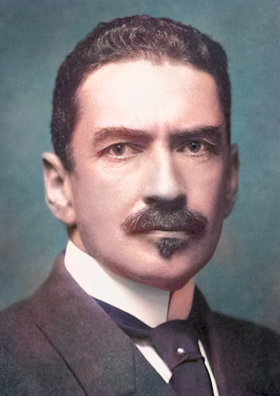
Hans von Euler-Chelpin (1873 – 1964))
On February 15, 1873, German-born Swedish biochemist Hans von Euler-Chelpin was born. Hans von Euler-Chelpin shared the 1929 Nobel Prize for Chemistry with Sir Arthur Harden for work on the role of enzymes in the alcoholic fermentation of sugar.
Youth and Education
Hans von Euler-Chelpin was the son of the later Bavarian Major General Rigas von Euler-Chelpin (1837-1923)and his wife Gabriele Furtner († 1931). He spent most of his childhood with his grandmother in Wasserburg am Inn. He went to the royal secondary school in Augsburg, followed by Würzburg and Ulm and passed the Abitur at the Wilhelmsgymnasium Munich in 1891. He volunteered in the Bavarian first Field Artillery Regiment and after one year in 1891, he began studying art at the Munich Academy of Painting and was taught by the German artist Ludwig Schmid-Reutte. Euler-Chelpin then went to attend the University of Berlin to study chemistry under Emil Fischer, and physics under Emil Warburg and Max Planck. Hans von Euler-Chelpin received his doctorate degree in 1895. with a thesis on “About the action of molybdenum trioxide and paramolybdates on normal vanadates, and a new method for the determination of vanadium pentoxide and molybdenum trioxide next to each other“.
Academic Career
Euler-Chelpin became after his doctorate and a short course on physical chemistry in Berlin a research assistant at the universities in Göttingen (1896 to 1897) and from 1897 in Stockholm, where he received his habilitation at the Royal University at Stockholm in 1899 and was subsequently appointed Professor of General and Organic Chemistry in 1906. Even though the scientist took Swedish citizenship, he took part in voluntary service in the German Air Force during World War I and worked in a diplomatic mission on the German side during World War II. In 1929, Euler-Chelpin became director of the newly created Institute for Vitamins and Biochemistry at the university there. He retired in 1941, but continued his research at the universities in Göttingen (1896 to 1897) and from 1897 in Stockholm, where he habilitated in 1899 and worked as a private lecturer in physical chemistry.
Work in Biochemistry
Hans von Euler-Chelpin‘s first work in the field of biochemistry was published in 1904. He dealt with physico-chemical and biochemical problems starting from 1906 and he worked on the chemistry of the fungi starting from 1915. From 1925 until 1930 von Euler-Chelpin worked on the chemistry of enzymes.
Fermentation
However, already around 1905, von Euler-Chelpin began to study he first phases of fermentation and their catalysis. In his work, Hans von Euler-Chelpin paid special attention to co-zymase and along with his collaborators, the scientist was able to clarify its structure. During the 1920s von Euler-Chelpin began studying vitamins and along with his collaborators including Paul Karrer and Margareta Rydbom he carried out a study of the marked vitamin A activity of carotene. At the Institute established in Stockholm by the Wallenberg and Rockefeller Foundations, von Euler-Chelpin’s work on fermentation and general enzyme chemistry was continued with special attention being given to the use of enzyme chemistry for the study of heredity and the blood serum.
The Nobel Prize for Chemistry
Jointly with Arthur Harden, Hans von Euler-Chelpin was awarded the Nobel Prize for Chemistry for his work on alcoholic fermentation. Euler-Chelpin managed to describe what happens in sugar fermentation and the action of fermentation enzymes using physical chemistry. This explanation led to the understanding of the important processes taking place in the muscles for the supply of energy.
Later Life
Already in 1914, von Euler-Chelpin had published a work on the chemistry of yeast and alcoholic fermentation. One decade later he managed to ambody the results of his research in enzymology in his monograph entitled Chemie der Enzyme, which was the first modern monograph on this subject. When he retired, his main focus was on cancer research. During the 1950s, von Euler-Chelpin collaborated on a book on the chemistry and biochemistry of reductones. Hans von Euler-Chelpin traveled to Japan during the 1950s, collaborating on a monograph on the reductones in collaboration with Professor K. Yamafuji and Drs. Namura and Adachi.
Hans Euler-Chelpin became the husband of Astrid Cleve, the daughter of the Uppsala chemist Per Teodor Cleve. Euler-Chelpin was the great-great-great grandson of Leonhard Euler [4] and his son Ulf von Euler, was awarded the Nobel Prize in Physiology or Medicine in 1970.
JoAnne Stubbe, 5. Enzymes and Catalysis, [7]
References and Further Reading:
- [1] Hans von Euler-Chelpin at the Nobel Prize Foundation Webpage
- [2] Hans von Euler-Chelpin at Britannica
- [3] Hans von Euler-Chelpin at Stockholm University
- [4] Read Euler, he is the Master of us all…, SciHi Blog, September 18, 2015.
- [5] Max Planck and the Quantum Theory, SciHi Blog
- [6] Hans von Euler-Chelpin at Wikidata
- [7] JoAnne Stubbe, 5. Enzymes and Catalysis, MIT 5.07SC Biological Chemistry, Fall 2013, MIT OPenCourseWare @ youtube
- [8] Works by or about Hans von Euler-Chelpin at German National Library
- [9] Timeline of Nobel Laureates in Chemistry, via Wikidata





